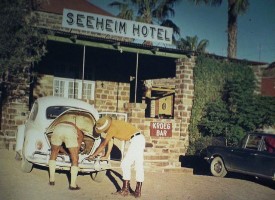
Built from local rock in 1896 to house Schutztruppe (German colonial forces), it was converted into a hotel in the roaring twenties, and became the pivotal place of activities as the town of Seeheim prospered and grew.
A little-known fact is that during the forties and fifties Seeheim was larger and of greater prominence than Keetmanshoop. It had a railway station, several churches and shops, a school, three hotels and a flourishing residential area. Then in the late fifties, the town gradually fell into decline. The school closed down and the residents began to leave. During 1974 the B2 was re-directed and the Seeheim Hotel finally shut shop.
After standing empty for 30 years, Zirkie Kloppers renovated the building and brought it back to life. The furniture (all of which is brand new and made by Zirkie himself), the curtains and other fittings as well as the new outbuildings for additional accommodation have been styled to suite the turn-of-the-century architecture and atmosphere of the original stone building.
For visitors interested in the historical aspects of the surrounding, there are ruins to explore, while the activities of the Schutztruppe are evidenced by an evocative of rusting ammunition scattered in the surrounding foothills. Future plans include the restoration of two historical railway dwellings to accommodate groups and families, and the development of camping facilities.

Close to Seeheim is the farm Naiams which runs down the Fish River. The tarred road to Lüderitz runs through this farm. Over a 100 years ago this farm belonged to an Englishman named Wheeler who lived with his family in a house made of stone and clay. They had very strong fountains on the farm where they produced fruit and vegetables. These fountains were on the road for the transport riders from Lüderitz to Keetmanshoop to the interior. Here mules, oxen, camels and horses were watered. He had ship sails and masts on the wagons and when the wind blew in the right direction he hoisted the sails to help the oxen over the sand.
There was also a German Garrison stationed at Naiams. The ruins of the fort are still there. The wagons had to pass through very hilly terrain and the Nama Hottentots used to lay ambush for the wagons. Hence the presence of troops.

About 10km from Seeheim the Fish River pushes through a narrow gorge and a spectacular waterfall forms and the river falls into the Fish River canyon. Farmers in the district call it the "Groot Kloof" but it is much more than that. The canyon and a similar one along the Konkiep course some kilometers away may be compared in peculiar magnificence with the grand Canyon of the Colorado river. In places, the Fish River Canyon is 10 kilometers broad and probably 3000 feet deep, about half the width and depth of the Colorado canyon.
The "Slangkop" (snakes head) mountain is situated close to Seeheim. During the Nama Hottentot and the German Forces war, the Hottentots gave it that name. The Germans had various Heliograph Stations dotted over the South of Namibia to send messages. Below "Slangkop" the Germans had a number of troops stationed to man the hill. The barracks still stands and is used as a home by a Mr Erens Schneidman. The troops had to climb this steep hill everyday. The Namas saw the bright light shining out of the mountain and took this to be the eye of the snake. They said the snake was sympathetic toward the German troops and flew from mountain to mountain to protect the German troops.


